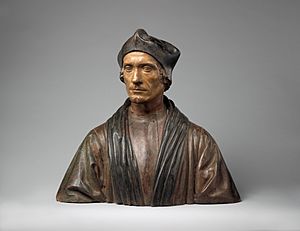John Fisher facts for kids
Quick facts for kids Saint John Fisher |
|
|---|---|
| Cardinal Bishop of Rochester |
|
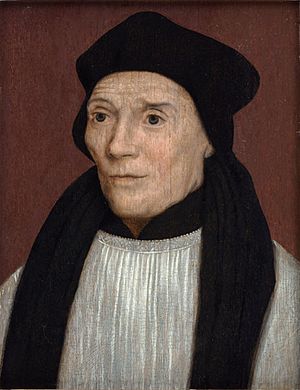
Depicted by a follower of Hans Holbein the Younger
|
|
| Church | Catholic Church in England and Wales |
| Metropolis | Canterbury |
| Diocese | Rochester |
| See | Rochester |
| Appointed | 14 October 1504 |
| Enthroned | 24 April 1505 |
| Reign ended | 2 January 1535 |
| Predecessor | Richard FitzJames |
| Successor | Nicholas Heath |
| Other posts | Cardinal-Priest of San Vitale |
| Orders | |
| Ordination | 17 December 1491 |
| Consecration | 24 November 1504 by William Warham |
| Created Cardinal | 21 May 1535 |
| Rank | Bishop, Cardinal-Priest |
| Personal details | |
| Born | c. 19 October 1469 Beverley, Yorkshire, Kingdom of England |
| Died | 22 June 1535 (aged 65) Tower Hill, London, Kingdom of England |
| Motto | faciam vos fieri piscatores hominum ("I shall make you fishers of men") |
| Coat of arms |  |
| Sainthood | |
| Feast day |
|
| Venerated in | Catholic Church, Anglicanism |
| Title as Saint | Bishop and martyr, Bishop of Rochester |
| Beatified | 29 December 1886 Rome, Kingdom of Italy, by Pope Leo XIII |
| Canonized | 19 May 1935 Vatican City, by Pope Pius XI |
| Patronage | Roman Catholic Diocese of Rochester; Rochester, New York |
| Styles of John Fisher |
|
|---|---|
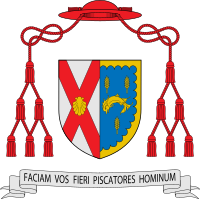 |
|
| Informal style | Cardinal |
John Fisher (born around October 19, 1469 – died June 22, 1535) was an important English Catholic leader. He was the Bishop of Rochester from 1504 to 1535. He also led the University of Cambridge as its chancellor. Today, the Catholic Church honors him as a martyr and a saint.
King Henry VIII ordered Fisher's death during the English Reformation. This was because Fisher would not accept Henry as the main leader of the Church in England. He also strongly believed in the papal supremacy, which means the Pope's authority. Fisher was made a cardinal just before he died.
On May 19, 1935, Pope Pius XI declared John Fisher and Thomas More to be saints. They are remembered as important Catholic martyrs from England. Both saints share a special day of remembrance, called a feast day, on June 22 in the Catholic Church. John Fisher's name also appears in some Anglican calendars.
Contents
- Early Life and Family
- John Fisher's Education
- Becoming a Bishop
- Standing Against New Ideas
- Supporting Queen Catherine
- King Henry's Actions Against the Church
- Strange Events: Poison and a Cannonball
- Secret Talks with the Emperor
- King Henry's Big Problem
- Refusing the Oath
- Becoming a Cardinal and His Death
- His Writings
- Becoming a Saint
- Places Named After John Fisher
- Portraits and Relics
- See also
Early Life and Family
John Fisher was born in Beverley, Yorkshire, England, in 1469. His father, Robert Fisher, was a successful merchant. John was one of four children. Robert Fisher died in 1477 when John was eight years old. His mother, Agnes, later remarried and had four more children. John likely went to school at the church in his hometown. He stayed close with his family throughout his life.
John Fisher's Education
John's mother saw that he loved learning. She was able to send him to the University of Cambridge in 1482. He was about twelve or thirteen years old at the time.
Cambridge University was not doing very well academically then. Fisher later said that learning had started to decline. This was perhaps due to problems in the town or frequent illnesses. Many top scholars were lost, and there was not enough support for learning.
Fisher studied at Cambridge from 1484 at Michaelhouse. There, he was influenced by William Melton. Melton was a religious scholar who was open to new ideas from the Renaissance. Fisher earned his first degree, a Bachelor of Arts, in 1487. In 1491, he earned his Master of Arts degree. He was also chosen to be a fellow at his college.
In 1491, Fisher received special permission to become a priest even though he was young. He was ordained on December 17, 1491. He was also named the Vicar of Northallerton, Yorkshire.
In 1494, he left this church role to become a university official called a proctor. Three years later, he became a leading debater. Around the same time, he also became a chaplain and confessor to Margaret Beaufort. She was the mother of King Henry VII.
On July 5, 1501, Fisher earned his doctor of sacred theology degree. Ten days later, he was elected Vice-Chancellor of the university. Under Fisher's guidance, Lady Margaret founded St John's and Christ's Colleges at Cambridge. She also created special divinity professorships at both Oxford and Cambridge universities. Fisher himself became the first professor in the Cambridge position. From 1505 to 1508, he was also the President of Queens' College. In July 1516, he was at Cambridge for the opening of St John's College and blessed its chapel.
Fisher worked to raise money and bring top scholars from Europe to Cambridge. He encouraged the study of Classical Latin, Greek, and Hebrew. He believed strongly in priests being committed to their communities, especially through preaching. Fisher put all his energy into this vision. He managed the entire university, one of only two in England, and completed many long-term projects.
Fisher also supported prayers for the dead. He was a serious and strict man. It is said that he would place a human skull on the altar during Mass and on his table during meals.
The famous scholar Erasmus said about John Fisher: "He is the one man at this time who is incomparable for uprightness of life, for learning and for greatness of soul."
Becoming a Bishop
On October 14, 1504, Fisher was made bishop of Rochester. This happened because King Henry VII personally insisted on it. Rochester was the poorest church area in England. It was usually seen as a temporary first step for a bishop. However, Fisher chose to stay there for the rest of his life, which was 31 years.
Like other English bishops, Fisher also had duties for the state. This included his important role at the University of Cambridge, which he cared deeply about. In 1504, he was elected the university's chancellor. He was re-elected every year for 10 years. Eventually, he was given the job for life. At this time, he is also said to have taught the future king, Henry VIII. Fisher was a very famous and skilled preacher. He was chosen to give the funeral speeches for King Henry VII and Lady Margaret, both of whom died in 1509. These speeches still exist today. Besides helping Lady Margaret with her foundations, Fisher also showed his passion for learning by inviting Erasmus to visit Cambridge. Erasmus said that because of Fisher, the study of Greek was allowed at Cambridge without the problems it faced at Oxford.
Despite his fame, Fisher soon had disagreements with the new King, Henry VIII. The problem started over money left by Lady Margaret, the King's grandmother. This money was meant for new buildings and programs at Cambridge.
In 1512, Fisher was chosen to be one of England's representatives at the Fifth Council of the Lateran in Rome. But his trip was delayed and eventually canceled.
Standing Against New Ideas
John Fisher was the first religious scholar to say that "justification through faith alone" was the main idea of the Protestant Reformation.
Some people have suggested that Fisher wrote the King's book against Martin Luther. This book was called "Assertio septem sacramentorum" (Defence of the Seven Sacraments). It was published in 1521. This book earned King Henry VIII the title "Fidei Defensor" (Defender of the Faith). Before this, Fisher had spoken out against problems in the Church. He urged for better rules and practices.
In 1523, Fisher wrote a very long response to Martin Luther's book. It was called "Assertionis Lutheranae Confutatio" (Confutation of the Lutheran Assertions). Luther did not reply to Fisher's arguments.
Around February 11, 1526, Fisher gave a famous sermon against Luther. He did this at St Paul's Cross, an outdoor pulpit in London. This was part of a public event where some Lutherans would publicly reject their beliefs. Also, books by Luther were burned. In his printed sermon, Fisher offered to meet secretly with any Lutheran. He hoped they could agree, or he could convince them to become Catholic. Fighting against new religious ideas became a major focus for Fisher in his later years.
In 1529, Fisher was asked to talk with Thomas Hitton. Hitton was a follower of William Tyndale and was suspected of heresy (holding beliefs against church teachings). Fisher confirmed Hitton's statements to Archbishop William Warham. He tried to convince Hitton to change his mind. When Hitton refused, he was given to the government and executed for heresy.
Supporting Queen Catherine
When King Henry VIII tried to end his marriage to Catherine of Aragon, Fisher became the Queen's strongest supporter. He spoke for the Queen in court. He surprised everyone with his direct words. He said he was ready to die for the idea that marriage cannot be broken, just like St John the Baptist. Henry VIII was very angry when he heard this. He wrote a long speech in Latin to the judges to answer Fisher. Fisher's copy of this speech still exists. His notes in the margins show he was not afraid of the King's anger. The case was moved to Rome, which ended Fisher's direct involvement. But the King never forgave him.
King Henry's Actions Against the Church
In November 1529, King Henry's "Long Parliament" began to take away the Catholic Church's powers. Fisher, as a member of the House of Lords, immediately warned Parliament. He said such actions would destroy the Catholic Church in England. The Commons, through their speaker, complained to the King that Fisher had disrespected Parliament. Henry probably encouraged them to do this. Henry called Fisher to explain himself. After Fisher explained, Henry said he was satisfied. But then the Commons said the explanation was not enough. This made Henry look like a kind ruler, not Fisher's enemy.
A year later, in 1530, the ongoing actions against the Church led Fisher, as Bishop of Rochester, along with other bishops, to ask the Pope for help. This gave the King an opportunity. An order was immediately issued forbidding such appeals. The three bishops were arrested. Their imprisonment must have been short. By February 1531, church leaders met, and Fisher was present. At this meeting, the clergy were forced to pay a large sum of money. This was to get the King's forgiveness for recognizing Cardinal Wolsey's authority as the Pope's representative. At the same time, they had to recognize Henry as the supreme head of the Church in England. Fisher helped add the phrase "so far as God's law permits" to this statement.
Strange Events: Poison and a Cannonball
A few days later, several people in Fisher's household became sick after eating porridge. Two of them died. Fisher himself was fasting that day, so he did not eat the porridge. King Henry VIII had Parliament pass a special law. This law allowed the cook, Richard Roose, to be executed for the crime of poisoning. This happened without a public trial.
On another occasion in 1530, a cannonball fired from across the Thames River hit Fisher's house. It narrowly missed his study. People whispered that this was a warning or an attempt to harm him from the Boleyn family.
Secret Talks with the Emperor
Fisher also took part in secret plans to challenge King Henry. As early as 1531, he began communicating secretly with foreign diplomats. In September 1533, he secretly encouraged Holy Roman Emperor Charles V to invade England. He hoped this would remove Henry from power, combined with an uprising inside England.
King Henry's Big Problem
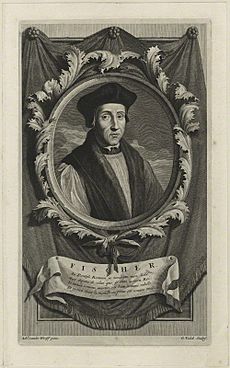
Things moved quickly now. In May 1532, Sir Thomas More resigned his high position as chancellor. In June, Fisher spoke publicly against the King's marriage annulment. In August, William Warham, the Archbishop of Canterbury, died. Henry immediately suggested Thomas Cranmer to the Pope as his replacement. In January of the next year, Henry secretly married Anne Boleyn. Cranmer became a bishop in March 1533. A week later, Fisher was arrested. It seems this arrest was to stop him from opposing the annulment, which Cranmer announced in May. It also aimed to prevent him from opposing Anne Boleyn's coronation on June 1. Fisher was released within two weeks of the coronation, with no charges against him.
In the autumn of 1533, some people were arrested because of the supposed visions of Elizabeth Barton, known as the Holy Maid of Kent. Fisher became very ill in December, so actions against him were delayed. However, in March 1534, a special law was passed in Parliament against Fisher and others. It accused them of being involved with the Maid of Kent. Because of this law, Fisher lost all his personal property. He was also to be imprisoned as long as the King wished. Later, he was pardoned after paying a fine of 300 pounds.
Refusing the Oath
The same Parliament session passed the First Succession Act. This law forced everyone to take an oath. This oath recognized Henry and Anne's children as the rightful heirs to the throne. Refusing the oath was considered a serious crime. Fisher refused the oath and was put in the Tower of London on April 26, 1534. Several attempts were made to make him agree, but he would not. In November, he was again found guilty of a serious crime. His goods were taken away, and the Bishopric of Rochester was declared empty. He stayed in the Tower for over a year. He was allowed food and drink from friends and a servant. But he was not allowed a priest, even at the very end. A long letter from Fisher to Thomas Cromwell describes the harsh conditions of his imprisonment.
Like Thomas More, Bishop Fisher believed that if he stayed silent, he would be safe. This was because the law only punished those who spoke "maliciously" against the King's new title. However, on May 7, he fell into a trap set by Richard Rich. Rich later lied under oath to get Thomas More convicted. Rich told Fisher that the King, for his own conscience, wanted to know Fisher's true opinion in strict secrecy. Fisher, once again, stated that the King was not the Supreme Head of the Church of England.
Becoming a Cardinal and His Death

In May 1535, the new Pope Paul III made Fisher a Cardinal Priest of San Vitale. The Pope hoped this would make Henry treat Fisher better. But it had the opposite effect. Henry forbade the cardinal's hat from being brought into England. He declared that he would send Fisher's head to Rome instead.
In June, a special group was formed for Fisher's trial. On Thursday, June 17, he was brought before a court of seventeen people in Westminster Hall. This group included Thomas Cromwell and Anne Boleyn's father. The charge was treason, because he denied the King was the Supreme Head of the Church of England. Since he had lost his position as Bishop of Rochester, he was treated like a common person and tried by a jury. The only person who testified against him was Richard Rich. John Fisher was found guilty and sentenced to be executed at Tyburn.
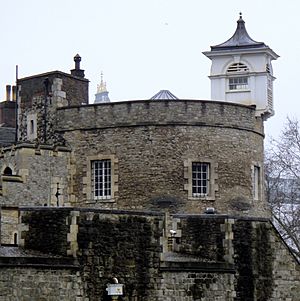
However, people in London were starting to protest. They saw a sad similarity between Fisher's conviction and that of his patron saint, Saint John the Baptist. Saint John the Baptist was executed by King Herod Antipas for questioning Herod's marriage. To prevent too much public sympathy, the King changed Fisher's sentence to beheading. This was to happen before June 23, the day before the feast of the Nativity of St. John the Baptist.
He was executed on Tower Hill on June 22, 1535. The execution had the opposite effect from what Henry VIII wanted. It created another parallel with the martyrdom of St. John the Baptist, who was also beheaded. His death also happened on the feast day of Saint Alban, the first martyr of Britain.
Fisher faced death with calm and dignity. This deeply impressed those who were there. His body was treated very harshly, seemingly on Henry's orders. There was no funeral prayer. Two weeks later, his body was moved next to Sir Thomas More in the chapel of St Peter ad Vincula inside the Tower of London. Fisher's head was placed on a pole on London Bridge. But its lifelike appearance attracted so much attention that, after two weeks, it was thrown into the Thames. Sir Thomas More's head took its place. More's execution, also at Tower Hill, happened on July 6.
His Writings
John Fisher wrote many works. There are twenty-six works in total, including printed books and manuscripts. Most of them are religious or argumentative writings. Several have been reprinted many times. The first editions are very rare and valuable. The main ones include:
- Treatise concernynge ... the seven penytencyall Psalms (London, 1508)
- Sermon ... agayn ye pernicyous doctrin of Martin Luther (London, 1521)
- Assertionis Lutheranae Confutatio (Confutation of the Lutheran Assertions) (1523)
- Defensio Henrici VIII (Cologne, 1525)
- De Veritate Corporis et Sanguinis Christi in Eucharistia, adversus Johannem Oecolampadium (Cologne, 1527)
- De Causa Matrimonii ... Henrici VIII cum Catharina Aragonensi (Alcalá de Henares, 1530)
- The Wayes to Perfect Religion (London, 1535)
- A Spirituall Consolation written ... to hys sister Elizabeth (London, 1735)
Becoming a Saint
| Saint John Fisher Bishop of Rochester |
|
|---|---|
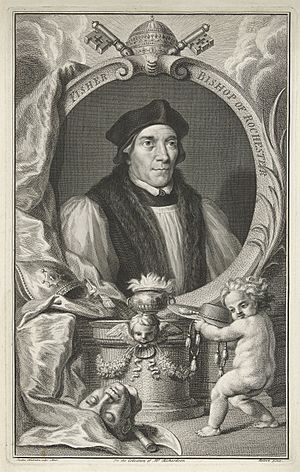 |
|
| Bishop and Martyr | |
| Born | 19 October 1469 Beverley, Yorkshire, Kingdom of England |
| Died | 22 June 1535 (aged 65) Tower Hill, Tower of London, London, Kingdom of England |
| Venerated in | Catholic Church |
| Beatified | 29 December 1886, Rome by Leo XIII |
| Canonized | 19 May 1935, Vatican City by Pius XI |
| Feast | 22 June |
John Fisher was beatified (declared blessed) by Pope Leo XIII on December 29, 1886. This happened along with Thomas More and 52 other English Martyrs. In the official declaration, Fisher was given the most important place.
He was canonised (declared a saint) with Thomas More on May 19, 1935, by Pope Pius XI. This followed a request from English Catholics. His feast day, celebrated with St Thomas More, is on June 22 (the date of Fisher's execution). In 1980, even though he opposed the English Reformation, Fisher was added to the Church of England's calendar of Saints and Heroes. He is remembered with Thomas More on 6 July (the date of More's execution) as "Thomas More, Scholar, and John Fisher, Bishop of Rochester, Reformation Martyrs, 1535." He is also listed in the calendars of saints for some other churches in the Anglican Communion.
Places Named After John Fisher
Australia
- St John Fisher College at the University of Tasmania in Hobart
- St John Fisher Catholic High school in Bracken Ridge, Queensland
- St John Fisher Church (Kurnell), Sydney, Australia
- St John Fisher Church (Tarragindi), Brisbane, Queensland
Canada
- St. John Fisher Catholic School, Scarborough
- Fisher Hall, a residence hall at Saint Michael's College at the University of Toronto
- St. John Fisher R.C. School, Forest, Ontario
- St. John Fisher Parish, Bramalea (Brampton), Ontario
- St. John Fisher Elementary School, Pointe-Claire, Quebec
United Kingdom
- The University of Cambridge:
- Fisher House, the Cambridge University Catholic Chaplaincy.
- Fisher Building, student housing at Queens' College, where Fisher was president from 1505 to 1508
- The Fisher Building, a conference center and meeting rooms in St John's College
- Schools:
- St John Fisher Catholic College in Newcastle-under-Lyme, Staffordshire
- St John Fisher Catholic High School in Harrogate, North Yorkshire
- St John Fisher Catholic High School in Peterborough, Cambridgeshire.
- St John Fisher Catholic High School, Wigan, Lancashire
- St John Fisher Catholic School in Chatham, Kent.
- St John Fisher Catholic Voluntary Academy in Dewsbury, West Yorkshire
- Ss John Fisher and Thomas More Roman Catholic High School, Colne, Lancashire
- The John Fisher School located in Purley, Surrey
- St John Fisher Catholic Primary School, Loughton, Essex
- Churches:
- Saint John Fisher parish, Kidbrooke, London
- Saint John Fisher Roman Catholic Church, Harrow, London
- Saint John Fisher Roman Catholic Church, Shepperton, London
- Saint John Fisher Roman Catholic Church, Rochester, Kent
- John Fisher R.C. Church, Scarthoe, Great Grimsby, Lincolnshire. (Closed 2017)
- Saint John Fisher R.C. Church, Priory Crescent, Southend on Sea, Essex
- Saint John Fisher Church, Cambourne, Cambridgeshire
- Other:
- St John Fisher House, Reading – the headquarters of the FSSP in England and Wales.
- The football teams Fisher Athletic F.C. (1908–2009) and Fisher F.C. (founded 2009) of Rotherhithe, south-east London
United States
- Fisher is the patron saint of the Roman Catholic Diocese of Rochester in New York State. It was named by Pope John XXIII in 1961.
- Because he was the Bishop of Rochester, Fisher is a patron of several places named Rochester, including:
- A number of other churches are also named after St. John Fisher, including those in:
- Rancho Palos Verdes, California
- Marlborough, Connecticut
- Chicago, Illinois
- Newtown, Ohio
- Tulsa, Oklahoma
- Portland, Oregon
- Boothwyn, Pennsylvania
- Churchill, Pennsylvania
- Galveston, Texas
- And the St. John Fisher Seminary Residence in the Catholic Diocese of Bridgeport, Connecticut.
Portraits and Relics
Several portraits of John Fisher exist. The most famous one is by Hans Holbein the Younger in the Royal Collection. There are also a few secondary relics (items connected to him) still around.
Fisher's walking-staff is owned by the Eyston family in East Hendred, Oxfordshire.
Portrayals in Film and TV
John Fisher has been played by actors in various films and TV shows:
- Joseph O'Conor in the film Anne of the Thousand Days (1969)
- Bosco Hogan in the series The Tudors
- Geoffrey Lewis in the 1971 miniseries The Six Wives of Henry VIII
- Richard Durden in the 2015 miniseries Wolf Hall
See also
 In Spanish: Juan Fisher para niños
In Spanish: Juan Fisher para niños


